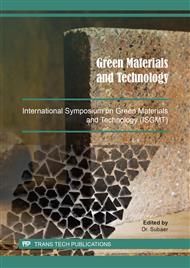[1]
I. K. Omurlu, K. Ozdamar, M. Ture. Comparison of Bayesian survival analysis and Cox regression analysis in simulated and breast cancer data sets. J. Expert Systems with Applications. 36 (2009) 11341–11346. https://doi.org/10.1016/j.eswa.2009.03.058.
DOI: 10.1016/j.eswa.2009.03.058
Google Scholar
[2]
D. G. Kleinbaum, M. Klein, Survival Analysis A Self-Learning Text, third ed., Springer US, New York, (2012).
Google Scholar
[3]
F. E. Ahmed, P. W. Vos, D. Holbert. Modeling survival in colon cancer: A methodological review. Molecular Cancer. 6 (2007) 1–12. https://doi.org/10.1186/1476-4598-6-15.
Google Scholar
[4]
I. K. Omurlu, , M. Ture, F. Tokatli, F. The comparisons of random survival forests and Cox regression analysis with simulation and an application related to breast cancer. Expert Systems with Applications. 36 (2009) 8582–8588. https://doi.org/10.1016/j.eswa.2008.10.023.
DOI: 10.1016/j.eswa.2008.10.023
Google Scholar
[5]
M. Chen, J. Ibrahim, Q. Shao. Maximum likelihood inference for the Cox regression model with applications to missing covariates. Journal of Multivariate Analysis. 100 (2009) 2018–2030. https://doi.org/10.1016/j.jmva.2009.03.013.
DOI: 10.1016/j.jmva.2009.03.013
Google Scholar
[6]
W. Y. Tsai. Pseudo-partial likelihood for proportional hazards models with biased-sampling data. Biometrika. 96 (2009) 601–615. https://doi.org/10.1093/biomet/asp026.
DOI: 10.1093/biomet/asp026
Google Scholar
[7]
K. Nagashima, Y. Sato. Information criteria for Firth's penalized partial likelihood approach in Cox regression models. Statistics in Medicine. 36 (2017) 3422–3436. https://doi.org/10.1002/sim.7368.
DOI: 10.1002/sim.7368
Google Scholar
[8]
A. Ramezankhani, F. Bagherzadeh-Khiabani, D. Khalili, F. Azizi, F. Hadaegh. A new look at risk patterns related to coronary heart disease incidence using survival tree analysis: 12 Years Longitudinal Study. Scientific Reports. 7 (2017) 1–11. https://doi.org/10.1038/s41598-017-03577-0.
DOI: 10.1038/s41598-017-03577-0
Google Scholar
[9]
A. Benedetto, C. Ercolani, M. Mottolese, F. Sperati, L. Pizzuti, P. Vici, P., … M. Maugeri-Saccà. Analysis of the ATR-Chk1 and ATM-Chk2 pathways in male breast cancer revealed the prognostic significance of ATR expression. Scientific Reports. 7 (2017) 1–10. https://doi.org/10.1038/s41598-017-07366-7.
DOI: 10.1038/s41598-017-07366-7
Google Scholar
[10]
B. Poerwanto, R. Y. Fa'rifah, W. Sanusi, S. Side. A matlab code to compute prediction of survival trends in patients with DHF. Journal of Physics: Conference Series. 1028 (2018). https://doi.org/10.1088/1742-6596/1028/1/012113.
DOI: 10.1088/1742-6596/1028/1/012113
Google Scholar
[11]
G. Roopashri, M. R. Vaishali, M. P. David, M. Baig, A. Navneetham, K. Venkataraghavan. Clinical and oral implications of dengue Fever: a review. Journal of International Oral Health : JIOH. 7 (2015) 69–73.
Google Scholar
[12]
A. Ihwah. The Use of Cox Regression Model to Analyze the Factors that Influence Consumer Purchase Decision on a Product. Agriculture and Agricultural Science Procedia. 3 (2015) 78–83. https://doi.org/10.1016/j.aaspro.2015.01.017.
DOI: 10.1016/j.aaspro.2015.01.017
Google Scholar
[13]
Lucio, P. S., Degallier, N., Servain, J., Hannart, A., Durand, B., Souza, R. N., Ribeiro, Z. M. A case study of the influence of local weather on Aedes aegypti ( L .) aging and mortality. J. Vector Ecol. 38 (2013) 20–37.
DOI: 10.1111/j.1948-7134.2013.12005.x
Google Scholar
[14]
F. M. Ojeda, C. Müller, D. Börnigen, D. A. Trégouët, A. Schillert, M. Heinig, T. Zeller, R. B. Schnabel, Comparison of Cox Model Methods in A Low-dimensional Setting with Few Events. J. Genomics, Proteomics and Bioinformatics. 14 (2016) 235–243.
DOI: 10.1016/j.gpb.2016.03.006
Google Scholar
[15]
T. L. Thein, Y. S. Leo, D. A. Fisher, J. G. Low, H. M. L. Oh, V. C. Gan, J. G. X. Wong, D. C. Lye. Risk factors for fatality among confirmed adult dengue inpatients in Singapore: A matched case-control study. PLoS ONE. 8 (2013)1-6. https://doi.org/10.1371/journal.pone.0081060.
DOI: 10.1371/journal.pone.0081060
Google Scholar


